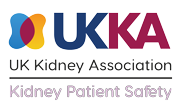
Introduction
The Kidney Patient Safety Committee (KPSC) aims to support healthcare professionals working in kidney care, to deliver safe, effective, person-centred care with the aim to improve the lives of people with kidney disease by providing or enhancing patient safety-related leadership. A sub-committee of the UK Kidney Association Clinical Affairs Committee, the KPSC reports to the UK Kidney Association Clinical Affairs Committee and the British Renal Society Council and works closely with the MHRA and NHS Improvement.
The KPSC meets once a month to discuss current patient safety issues and progress on identified areas and is co-chaired by Dr Katrin Jones and Karen Jenkins, with multi-professional and patient members. Any incidents and risks that have occurred to people with kidney disease can be reported to the KPSC via email: [email protected]
Membership
- Katy Jones: Co-chair, Consultant Nephrologist
- Karen Jenkins: Co-chair, Consultant Nurse
- Gerald Boyle: Renal Technician
- Paul Rylance: Consultant in General and Renal Medicine, RCP Patient Safety Committee Member
- Francesco Rainone: Consultant Nephrologist
- Janette Moran: Consultant Renal Psychologist
- Richard Ayres: Patient Representative
- Duncan Ferguson: NHS National Services Scotland
- Susan Spence: Welsh Kidney Network Manager
- Peter Foxon: Paediatric Renal Pharmacist
- Helen Spooner: Nurse Consultant
- Lynsey Stronach: Paediatric Advanced Nurse Practitioner
- Lisa Ancliffe: Occupational Therapist
- Vicky Pursey: Physiotherapist
- Dawn Moller: Nursing Director Diaverum
- Nicola Ward: Head of Nursing Renal Services
- Jane Tyler: BBraun
- Hayley Wells: Renal Pharmacist (Adult)
- Nabil Melham: Paediatric Nephrologist
- Emma Rooke: MHRA representative
- Gill Manning: ARI chair
- Jon Gooch: Country Manager, Nipro Medical UK Ltd
Shared Learning & Guidance
A patient on warfarin and aspirin started haemodialysis via a basilic vein transposition fistula. On the first dialysis session, there was a fistula “blow” and it was rested. Two days later, at the end of the second dialysis session, the venous needle was noted to be “bypassing” (there was evidence of bleeding around the needle at the insertion site). The needle was removed, and pressure applied. However, the bleeding did not stop and the patient’s condition deteriorated. The upper arm and chest wall were swollen with haematoma. The needle insertion site was sutured by the vascular surgeon with no further external bleeding. INR >11 and vitamin K and clotting factors given. Sadly the patient deteriorated and died.
Contributing factors:
- New fistula
- Deep fistula
- Unrecognised internal bleeding
- Very high INR
Learning points:
- Teams must be extra vigilant when cannulating a new fistula and undertake regular observations
- Blood loss can be underestimated
- Patients taking anticoagulants are at increased risk of fistula bleeds
- Prompt recognition of major fistula bleeding and initiation of local Major Haemorrhage Protocol is essential
The UKKA KPSC have produced a summary of known safety issues with dialysis and continuous renal replacement therapy (CRRT) describing what to do to minimise or prevent serious injury - produced in collaboration with the Medicines and Healthcare products Regulatory Agency.
Produced with the Association of Nephrology Nurses UK and the Welsh Renal Clinical Network, this document aims to provide standardised and patient centred guidance on the management of challenging behaviour in dialysis settings.
Management of Challenging Behaviour in Dialysis
Currently under review
All patients with haemodialysis vascular access are at risk of venous or arterial needle/line disconnection or dislodgement which is a life-threatening incident.
The UK Kidney Association Kidney Patient Safety Committee, in collaboration with ANN UK Vascular Access Community of Practice, VASBI (Vascular Access Society of Britain and Ireland) and Industry partners, have produced two new resources:
STOP guidance (Safety, Taping, Observation, Pressure monitoring) to enable patients/carers and health care professionals to maintain safety and reduce the risk of needle, line or catheter dislodgement/disconnection.
MARC poster (Mute, Assess, Reset, Confirm) to raise awareness of safe haemodialysis machine alarm handling.
Recent Safety Alerts
October 2023: The UKKA estimated Glomerular Filtration Rate (eGFR) Working Group has issued a Patient Safety Alert on the Lack of standardisation of kidney function measurement across the United Kingdom
December 2022: The UK Renal Pharmacy Group has issued a statement on safety considerations for the use of Metolazone preparations in adults
The MHRA has highlighted a Field Safety Notice about damage to MiniCap Extended Life PD Transfer Sets which can be caused by cleaning products such as hand sanitiser (or those containing hydrogen peroxide, bleach, alcohol or antiseptic agents) and solvents intended to remove adhesive residue (acetone, toluene, xylene, cyclohexanone).
Baxter has updated the Instructions for Use to include a warning against use of these cleaning products and solvents.
Reporting a patient safety concern
Incidents and risks that have occurred to kidney patients can be reported to us using this form.
- Incidents related to the care of kidney patients
- Incidents related to the use of renal devices or medicines
- Risks that have been identified that potentially might cause harm
We will, where indicated, discuss incidents and risks with NHS England and MHRA to ascertain whether similar issues have been reported to these organisations.
The Patient Safety Committee would be keen to support any unit planning to submit a report to MHRA.
Please include as much detail as possible in the form, but DO NOT include patient identifiable information. If necessary, more information can be exchanged at a later date over the secure NHS.net system.
Report a safety concern
Local reporting systems
All incidents that have caused, or might potentially have caused, harm to patients should always be reported via your local reporting system.
Any incident related to medicines or devices (equipment, disposables, computer equipment or software) should be reported to the MHRA by the Yellow form reporting form, via this link.
Serious incidents, particularly related to the failure of clinical practice, can also be reported directly to NHS England, via this link.